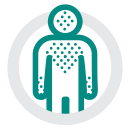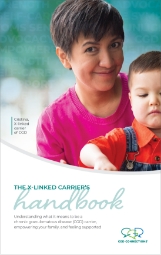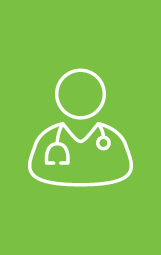Our topic today is genetics and genetic testing. This can be an overwhelming and complicated topic. That's why we have Chelsea Roadhouse, our genetics counselor, here to help with your questions. Chelsea, great to see you.
Chelsea: Thanks, Dr. Patel. It's great to see you, too, and it's a pleasure to be here today. Ah, genetics, genetic testing—it's a complicated subject and I've spoken with hundreds of families that have lots of questions about all of this. Some families, they don't even know what questions to ask, but they're looking for more information. So, this is a great opportunity to answer some of those frequently asked questions for the CGD community.
Chelsea: I'll take the first question, which is: Can you explain the role of a genetic counselor?
Chelsea: A genetic counselor is a healthcare provider who has expertise in genetics, genetic testing, genetic conditions. Our role is to help explain genetic concepts to families so they can understand how their DNA can play a role in their health. We help families understand the genetic process—the testing, what it involves, possible results and next steps, pros and cons of testing—so that each of our families can make the decisions that are right for them. We also help to empower and support families as they adjust to a genetic diagnosis and help them to be advocates amongst their family members, their communities, and with their healthcare providers.
Dr. Patel: Here's a good question: "What types of testing are there for CGD?"
Dr. Patel: There are several types of testing for CGD. The most common is called a dihydrorhodamine assay, or DHR. It is a good initial screening test for chronic granulomatous disease. It detects the production of a chemical called superoxide. That superoxide is important by killing different types of microbes by your white blood cells. In the presence of CGD, the DHR assay will be abnormal, in that it will not pick up that superoxide production.
Another test, called genetic testing, can identify a variant or mutation that is the cause of CGD.
Dr. Patel: Another question we received is: "What will the test results tell me?"
Dr. Patel: The genetic test results that you get can be either positive or they can be negative, or they can be uncertain. In the cases of a positive test, that will indicate whether you might be affected by CGD or whether you're a carrier. In the case of a negative test result, that concludes that you do not carry the gene for CGD. Sometimes the test can come back as uncertain, and in that chance, you should really talk to your immunologist and genetic counselor to determine the next steps.
Dr. Patel: Another question is one we hear all the time: "Why is genetic testing important, and do we really need it?"
Dr. Patel: Genetic testing is hugely important. Genetic testing can confirm the initial positive results of a screening test, which obviously is important. The other thing that genetic testing can help do is—if the initial screening test results are inconclusive— genetic testing can help confirm whether the test result is positive or negative.
As a clinician, the genetic test results can be used to predict whether patients will have a more severe course, such as with X-linked CGD, or a less severe course, as is often seen with autosomal recessive. And for planning purposes, genetic testing can help decide if carriers who carry the disease, can receive genetic counseling and understand their risk for passing on that gene to offspring.
Chelsea: Exactly. I would also agree that genetic testing is very important. It gives us a great tool to screen other family members who they themselves may have CGD or who may be carriers. Some families wonder which branches of the family tree could be affected or what it means when they're having families of their own. And those genetic tests offer us a great tool for answering those questions.
Chelsea: I love this next question—so many people will relate to it.
Chelsea: My mother is in denial that our side of the family has CGD in our genes. I think she might be a carrier herself and that some of her lupus-like symptoms are because of CGD. But she won't listen to me when I try to talk to her about it. Any advice?
Chelsea: Many families tell me that it can be difficult to talk about the CGD diagnosis with their relatives. I always encourage our families to remember that there can be a lot of emotions at play when thinking about testing for CGD. Some individuals might not want to admit that they're experiencing symptoms or might not want to be seeking out additional medical support—that denial example you've used.
Other family members might feel a sense of responsibility if they think that it's something that they've passed on to their families. It's important to remind them that we don't get to control the genes that we inherit or the genes that we pass on. It's just a part of ourselves.
Dr. Patel: I completely agree, Chelsea. I think it's important to be open, honest, and acknowledge some of the barriers that come along with disclosing your diagnosis and encouraging other family members to get tested. There may be barriers, such as financial, or even the impact of what a positive test would be. Ultimately, be firm, and be strong, but be very supportive no matter what the decision is.
Chelsea: Cost is always an important consideration when it comes to anything related to our healthcare, so this is an important question to address.
I'm hesitant to get genetic testing because I'm not sure I can afford it. What should I do?
Chelsea: Many families have questions about the cost of genetic testing and if it's truly available to them. Many insurance companies do cover genetic testing, so we would encourage you to speak with your insurance company to see what options are available. You can also discuss this with your healthcare provider or the genetic testing laboratory itself. Don't let cost be the one thing to get in the way of you having a genetic test. Work with your insurance, your healthcare providers, and the labs to help this be available to you.
Dr. Patel: Those are great questions. If you have other questions, feel free to reach out to your CGD Nurse Advocate.













